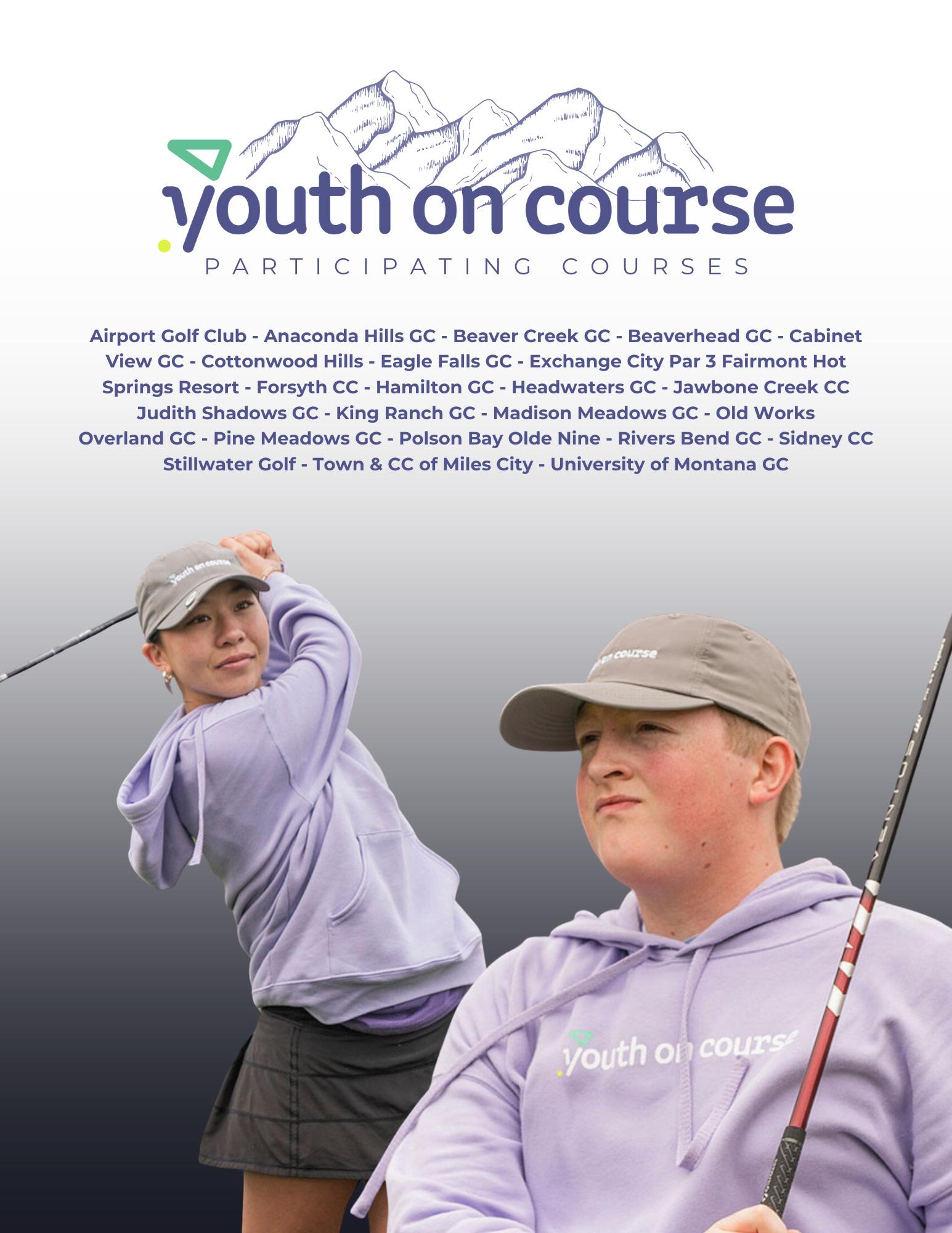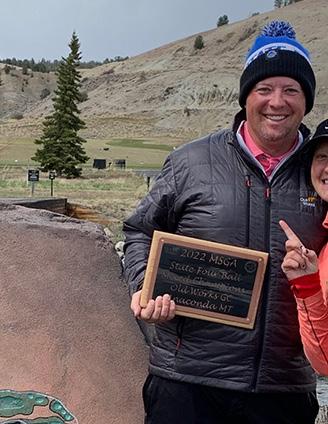






The MSGA team has completed our busiest stretch in an already packed slate of events.
In general, golfers tend to share a universal trait: we’re never quite satisfied with our results. I’ve opined more than a few times that the key to enjoying this maddening game is to find something—anything—that brings you joy on the course. Golf is famously frustrating, but it’s also rewarding, with plenty of life lessons along the way—some gentler than others.
One lesson that keeps making itself obvious? Everyone loves good pace of play.
Watching the group ahead of you engage in a hole-by-hole competition of poison between the tee markers as you wait for the group ahead to finish is not the dream. A brisk round, on the other hand—whether it’s a charity scramble or a stroke play championship—can turn a good day into a great one. Golf is just better when play is continuous, and the rhythm is right.
At the State Juniors, we work with kids of all ages and experience levels. For many of our under-13 competitors, this is their first tournament experience, and just seeing a scorecard with "hole-by-hole timing" can spark anxiety. Even seasoned players get nervous when timing volunteers are stationed on the course.
Our State Amateur Championships bring out the most first-tee nerves of the season. Competing on a championship course doesn’t always lead to championship performances— but that doesn’t mean the round has to take forever. I've seen rounds in the low 70s drag
2 - 406GOLF - JULY 1, 2025

on for nearly six hours and 120s wrapped up in under four.
So, if we all agree that we prefer a fourhour round to a five-hour slog, why does the train so often get derailed? More importantly: how can we keep things moving?
Here are 10 tips from our time running events that will help you keep the group on pace (and the group behind from giving you the death stare):
A relaxed player is a faster player. Having to go back to your car for that extra sleeve of balls, sunscreen, or forgetting you had two putters is in your bag is easier to deal with when you're early. Hustling to the tee box with your shoelaces untied is not the vibe. A relaxed swing and mind are a good combination to start the round.

2. Think ahead.
Start planning your next shot before you reach your ball. Socializing is great but be ready to switch gears. Know your yardage, lie, and club options before it's your turn. Then you can be decisive and unhurried, because you’re prepared! (Hat tip: Katie Fagg)
3. Watch your shot (even if it hurts).
It’s tempting to look away in disgust after skulling one or a violent miss left or right— but watching your ball (and your partners’) helps everyone locate shots faster. That means less wandering and fewer impromptu search parties. (Hat tip: Ella Prigge)
4. Be green-ready.
Greens are where pace of play often goes to die. You can watch others putt and read your putt and get aligned at the same time. Be ready to roll when it's your turn—especially in a foursome where 120-150 putts per round isn’t uncommon.

5. Don’t get lost at the turn.
The halfway point is not a halftime locker room session. If you're planning to eat, call in your order ahead or grab and go. No one wants to wait on the tee because your hot dog journey turned into a seated lunch.
6. Play “ready golf.”
Etiquette is important—but being courteous doesn’t mean you can’t ever play out of turn. If you’re ready to hit and someone else is fiddling with their glove, go for it. Letting your group know you’re okay with ready golf is always a good option. That said, don't ever hit out of turn when someone in your group just made a birdie. That’s sacred territory. (Fun fact: It's not a real rule. If someone says it’s fine, do not fall for it. Everyone wants to have the tee box after a birdie.
7. Putt out when you can.
If it’s a short putt and no one minds, go ahead and finish instead of marking. Those


seconds add up over 18 holes—and three other players. Don’t rush it at the risk of a miss, but as Happy Gilmore would advise, “just tap it in.”
8. Limit practice swings.
If you’re reading this, you’re probably not on tour. One or two swings to get a feel is fine—just don’t rehearse your entire pre-shot routine like it’s opening night on Broadway.
9. Keep your cart strategy sharp.
If you're riding, drop one player off and head to your ball. Don't both sit and wait for each other like you're on a Sunday drive. Same goes for grabbing your preferred weapons—bring the enough clubs with you when you walk over in case the lie isn’t a preferred one.
10. Accept that bad shots happen —move on.
The fastest golfers are the ones who don't dwell. Hit it, find it, hit it again. Reflect in the car ride home and save your partners from your temper tantrums or on-course pontifications about what went wrong.
Golf is meant to be fun. It's more fun when you’re not standing in the fairway wondering if the group ahead is laying sod for a new green. Whether you’re a junior player, club champ, or weekend warrior—keeping pace means more enjoyment for everyone. Let’s all do our part to make sure the only thing slow about a round of golf is your friend’s search for their wallet when the beverage cart arrives.

BOARD OF DIRECTORS - OFFICERS
PRESIDENT................................................... Peter Benson
VICE PRESIDENT.................................. Ron Ramsbacher
TREASURER....................................................... Bill Dunn
PAST PRESIDENT......................................... Mary Bryson
EXEC COMMITTEE......................................... Karen Rice
BOARD OF DIRECTORS
Brett Bennyhoff, Peter Benson, Carla Berg, Mary Bryson, Bill Dunn, Cheri Ellis, Lisa Forsberg, Marcia Hafner, Ron Ramsbacher, Karen Rice, Joe Rossman, Rod Stirling
MSGA STAFF
Executive Director......................................... Nick Dietzen
Tournament Director...................................... Tim Bakker
Membership Operations Director............... Emily Hulsey
Member Services Coordinator......................... Ian Hulsey
Communications & Tournament Manager.... Katie Fagg
Communcations Coordinator.......................... Ty Sparing
Partnerships & Business Development.......... Jess Miller
USGA PJ Boatwright, Jr. Intern................ Dean Hendrix
USGA PJ Boatwright, Jr. Intern...................... Ella Prigge
USGA PJ Boatwright, Jr. Intern................ Stella Claridge
Jess Miller.................................. 1 (800) 628-3752, ext. 5
406GOLF STAFF
Editor in Chief............................................... Nick Dietzen
Consulting Editor........................................ David Bataller
Senior Writer..................................................... Ty Sparing
Graphic Designer............................................... Katie Fagg
Contributing Writer............................ Macee Greenwood
Contributing Writer.......................................... Pete Grass
Contributing Writer..................................... Sydney Jones
Contributing Writer......................................... Tom Gould









BY KATIE FAGG MSGA Communications and Tournaments Manager
Nestled in East Missoula, the highly-anticipated Canyon River Golf Club opened for play in July of 2006. Designed by the internationally renowned Schmidt-Curley Golf Design company, in less than 20 years Canyon River has established itself as one of Montana’s most sought after courses, and acts as a frequent host to state events.
The rolling terrain, natural elevation changes, and strategically placed bunkers keep play -

ers on their toes while offering incredible views of the Missoula Valley. Hugging the Clark Fork River tightly, Canyon River provides golfers with sweeping views of the surrounding Rocky Mountains and lush landscapes that the Missoula Valley is famous for. You might even see a little wildlife on the course, just don’t let the foxes steal your golf balls.
The course spans just under 7,000 yards and features 18 holes of championship-caliber golf that cater to players of all skill levels. While it’s known by some for its difficult downhill par3s, the course is yet accessible to golfers of all skill levels.


As Jeff Hardee, a former longtime golf professional at Canyon River, tells us: “If I had to play one course everyday, it would be Canyon River. There are so many different ways to play the course. You can make it as easy or as difficult as you want. With immaculate course conditions and a tight knit community, what more can you ask for?”
It is clear that Canyon River has something for everyone. Once done on the course, hungry golfers also have the option to dine at the “Fox Den,” Canyon River’s on-site restaurant. With breakfast options in the morning and an array of delicious oven-toasted sandwich options for lunch, the Fox Den can satisfy all appetites.
The Montana State Golf Association is thrilled that Canyon River will host the 2025 Montana State Women’s Amateur and Master 40 Championships this July 10-12. The 54-

hole event will attract the top female amateur golfers from across Montana, showcasing the state's talent on a scenic stage.
Canyon River is also slated to host the 2025 PNW PGA Professional Championship later this year in September. The event will feature top PGA professionals from across the Pacific Northwest fighting for a spot in the 2026 PGA Professional Championship. The tournament will be played over 54 holes, testing the skills and endurance of the region's best professionals.
With two major tournaments on its 2025 calendar, Canyon River Golf Club is set to be a focal point for competitive golf in Montana, offering players and spectators an opportunity to experience championship golf in a breathtaking setting.




BY TY SPARING
MSGA Communications Coordinator
The final round of the 108th Montana State Amateur Championships concluded on Saturday 6/28 at the Missoula Country Club, and it was Payton Taylor who managed to overcome Kade McDonough by one stroke. The sun was out with a few heavy wind gusts throughout the day as 160 golfers competed across three championships (State Amateur, Senior Amateur, Super Senior Amateur).
Payton Taylor (Missoula), a former Liberty University golfer (2014-2017), was extremely sharp with the putter in his final round, nailing a multitude of clutch putts on his way to a third-round score of -3 (68) and an overall score of -6 (207). Taylor, who was a State Ama-


teur runner up in 2017 when it was last held at the Missoula Country Club, and also a Barnett Memorial Champion in 2018, played bogey free golf when it mattered most as he recorded three birdies (holes, 3, 10, 11) and made 15 pars.
It didn’t come easy for Taylor, however, as the two-time Montana State Match Play Champion (2023-24), McDonough, kept right on his heels throughout the round. With a birdie on hole 18, McDonough put the pressure on Taylor who needed at least par to win. About five feet away from the hole, Taylor kept his nerves in check and drilled yet another putt, breathed a sigh of relief and can now call himself the 2025 Montana State Amateur Champion.
By virtue of his victory, Taylor will represent



Montana in the 125th U.S. Amateur Championship at Olympic Club in San Francisco.
McDonough, who recently won the U.S. Open Qualifier that was held at the Missoula Country Club just last month, notched three birdies over his final round, en route to an even par 71, and an overall score of -5 (208).
It wasn’t just McDonough that Taylor had to fend off as there was a four-way tie for third place at -3 (210). Missoula’s Sean Ramsbacher started his round on fire with five birdies over the first nine holes (2,4, 5, 8, 9), and collected three more on the back nine (10, 14, 18). It

was a classic Ramsbacher heater but coming into the final day five strokes back of first place, it wasn’t quite enough given his deficit coming into the round.
Along with Ramsbacher in third place was Brian Beach (Helena), Billy Smith (Whitefish), and Chase Choquette (Butte).
Rounding out the top ten was Joe Opitz (Missoula) in seventh place at -2 (211), Tye Boone (Billings) in eighth place at -1 (212) and a tie for ninth place at even par (213) between two Mining City golfers, David Starcevich and Scott Eide. John Gilbert of Helena posted the


low round of the day with 66 (-5) after a blistering 30 on the first nine of his round.
For Billings’ Jerry Pearsall it was a bit of déjà vu as he pulled out his second straight Senior Amateur Championship victory by two strokes after posting a final day score of -2 (69).
Coming into the third round two strokes out of third place, Pearsall recorded three birdies (holes 10, 12, 18) and tied Bob Hasquet for the lowest individual round of the tournament. For Pearsall this marks his second straight Senior Amateur Championship title to go along with two Montana State Senior Tournament wins (2019, 2024).
Following Pearsall in second place was Bob Hasquet (Missoula) at +2 (215) who was
playing in his very first Senior Amateur Championship. In third place was the 2022 State Senior Tournament champion Brad Grattan (Whitefish) who finished up at +3 (216).
MSGA Hall of Famer Bill Dunn (Missoula) placed fourth at +3 (216) and in fifth place was Jon Yousko (Bozeman) who ended his three rounds with a cumulative score of +9 (222).
In the Super Senior Amateur Championship Carl Funk ended his first round in a tie for first place at +1 (72) and held onto the top spot the rest of the way. The 2023 State Senior Match Play Champion, Funk, extended his lead over the next two rounds to achieve a four-stroke victory at +7 (220).
Following Funk in second place was three-
time Super Senior Amateur winner Corey Bedell (Missoula) who finished his three rounds at +11 (224).
Third place went to Steve Bell (Missoula) at +12 (225), Bruce Scott (Kalispell) finished in fourth place at +14 (227), and Lou Bahin (Missoula) rounded out the top five in the Super Seniors with a final score of +15 (228).
Along with the Amateur Champions being crowned, there was also the Barnett Cup and the Schwartz Trophy that certain players were competing over. The Barnett Cup, which goes to the lowest scoring two-man team’s desig-

nated by their home clubs went to Missoula Country Club’s McDonough and Ramsbacher.
The duo, who have captured previous Barnett Titles as well as a Four-Ball Championship in 2023 at Missoula Country Club etch their name again and bring the trophy to the home club of the namesake, Don Barnett of Missoula.
The Schwartz Cup is awarded to the lowest scoring junior player, and that distinction this year went to Butte’s Chase Choquette at -3 (210).



BY TY SPARING MSGA Communications Coordinator
This year marks the 108th annual Montana State Women’s Amateur Championship, one of the oldest sporting traditions in the state. The Butte Country Club held the first State Am in 1917, and in conjunction with the tournament the Montana State Golf Association was also created. Over the next century the event has rotated around some of the top courses the Treasure State has to offer and witnessed legendary performances from Montana’s very best golfers.
This year’s event will be held at the Canyon

River Golf Course in East Missoula, the second time the Women’s State Amateur has been played there. Relatively new to the Montana golfing scene, having just opened in 2006, Canyon River is not only picturesque, but provides a challenging course that will test a golfer's skillset.
Back in 2015 it was Big Sky’s Dorsey Addicks that took the crown at Canyon River, but in 2025 there’s an opportunity for a little history to be made. Montana State Bobcat All-Conference golfer Lauren Greeny will attempt to become just the sixth woman since 1917 to win the Women’s State Amateur Championship for three straight years. It


won’t come easy though as Greeny will have plenty of stiff competition from around the state. Corvallis’ Macee Greenwood, a current Boise State golfer, finished runner-up last year and is on the shortlist of players expected to compete for the title. Along with Greenwood, there are plenty of University of Montana golfers ready to take down Greeny’s reign of dominance including Hannah and Raina Ports, Kendall Hayward, and Bella Johnson, all of whom would love to bring the title back to Griz country. However it shakes out, we expect this year’s Women’s State Amateur Championship to be exciting as ever!
For the third year in a row the MSGA will award the Carla Berg Trophy for the junior (18 & under) who achieves the lowest gross score across all three rounds at the Montana State

Women’s Amateur Championships.
The award is dedicated to current MSGA board member, Carla Berg, in recognition of her years of service and advocacy for the game of golf in Montana. The first woman chosen to serve on the Board of Directors for the Montana State Golf Association, she was elected President several years later. Having also served as the President of the former Montana State Women’s Golf Association (MSWGA), Berg was instrumental in making sure the merging of the MSGA and MSWGA was a success.
Raised on a cattle ranch in Sidney, Berg has been a tireless advocate and steward for the game of golf in Montana. The sport is as vibrant as ever in 2025, and she is a true leader in making sure that trend continues for future generations. Her contributions towards junior golf are vast, and in recognition of her unique
role in shaping youth golfers in the state of Montana, the MSGA is proud to continue the tradition of awarding the Carla Berg Trophy.
Notes and Records from the Montana State Women’s Amateur Championship:
• Since 1917 there have been 53 total winners
• 21 winners of the Women’s State Amateur Championship have won multiple times
• Edean Anderson was the youngest to ever win the event at age 14. She won the next five consecutive after that

• From 1955-1975, Helen Tremper won the State Amateur fifteen times, and finished runner up five times
• Jewell Gronley Lee had the most runner ups with 7
• 11 different cities in Montana have hosted the event
• Five women won the title three or more years in a row (Mrs. I.M. Wheeler, Lue Jeanne Gronley, Edean Anderson, Helen Tremper x 2, and Cathy Studer)
• In the last 30 years, three women have won the event twice in a row (Rachel Warren 2007-08, Jasi Acharya 2004-05, Lauren Greeny 2023-24)

• Helen Schroeder Tremper (x 15)
• Edean Anderson (x 6)
• Grace Barnett (x 6)
• Jane Hibbard (x 6)
• Mrs. Frank Tucker (x 5)
• Mrs. Charles Branscombe (x 3)
• Lue Jeanne Gronley (x 3)
• Mrs. I.M. Wheeler (x 3)
• Cathy Studer (x 3)
• CeCe Studer (x 3)
• Jen McGregor James (x 3)
• Jewell Gronley Lee (x 2)
• Sally Sisk (x 2)
• Judi Schneider (x 2)
• Joanne Steele (x 2)
• Leslie Spalding (x 2)
• Rachel Warren (x 2)
• Jasi Acharya (x 2)
• Maggie Crippen (x 2)
• Lauren Greeny (x 2)



BY TY SPARING MSGA Communications Coordinator
Frenchtown phenom Katie Lewis made history this June as she cruised to her third straight Montana State Junior Championship title at the Fairmont Hot Springs Resort Golf Course, while Hamilton’s Brady Powell came out victorious after an exciting playoff finish in the boys’ division.
After a suspended second round was reduced to nine holes due to volatile weather conditions, a little sunshine came out with

a heavy dose of wind during the third day of play as the best youth golfers in the state put it all on the line at the most competitive junior tournament in Montana.
Lewis, who is bound for the University of Montana this fall, finished her third round at +5 (77) which put her at +9 (189) overall, giving her the win by four strokes and becoming just the first female golfer in state history to win three straight MHSA titles and three straight Montana State Junior Championships. She joins Billings’ Brandon McIver (2009-2011) as the only two junior golfers to



ever achieve the rare feat.
Starting the final round with a four-stroke lead, Lewis notched two early birdies (holes 3, 5) which gave her enough distance to play conservative and ultimately finish up the round where she started – four strokes ahead of second place. Following Lewis was Big Sky’s Cate Leydig, the 2023 Class C State Champion, who had a fabulous back nine as she finished the tournament with ten straight pars.
In third place was Great Falls’ Hanna Boyd at +15 (195). The 2024 Carla Berg Award recipient Boyd will take her talents to MSU-Billings next fall. Following Boyd was Kira Connell (Bozeman) in fourth place at +27 (207), and in fifth was Anna Lende (Livingston) who finished up her three rounds at +31 (211).
Hamilton’s Cameron Burnett won the Girls 14-15 Division with a final three-round score
of +37 (217). Following Burnett was Paige Loberg (Billings) at +39 (219) in second place, and in third place at +47 (227) was Breckin Frederick (Bozeman).
There was a bit of drama in the boys’ division as John Gilbert (Helena) and Brady Powell (Hamilton) were neck-and-neck for most of the round and required a playoff to determine the victor. Gilbert came into the day just one stroke ahead of Powell, propelled in part by a tournament low individual round of -5 (67) on the first day, but the two were back and forth atop the leaderboard for most of the final round, with Powell notching a clutch birdie on 16 to tie. Gilbert and Powell each had birdie opportunities on 18, with Powell missing and Gilbert lipping out. Ultimately, a playoff occurred on hole 10. Powell parred and Gilbert bogeyed in a hard-fought duel during the back nine.

For Montana junior golf fans, both Gilbert and Powell are familiar names atop High School leaderboards these last couple of years. In 2024 they both finished in the top five at the State Junior Championships with Powell as runner-up and Gilbert in fifth.
But, with last year’s champion Tye Boone off to college, the Montana State Boys Junior Champion had a vacancy that required a new golfer, and Gilbert and Powell were both deserving candidates for the honor.
Last year’s second-place finisher is now your 2025 Montana State Boys Junior Champion.
Tying for third place at -1 (179) was Polson’s

Class A State Champion Maxwell Milton, along with Billings’ Colin Jensen. Jensen’s round was highlighted by an eagle on the par-5 hole 10. In fifth place was Aubrey Kelley (Emigrant) who posted the lowest round of day three at -1 (71) and ended up at even par (180) after his three rounds were complete.
The Boys 14-15 Division Colin Jensen birdied the 10th to win on the first playoff hole over Maxwell Milton.
Thanks to all staff and volunteers that helped make the 59th Montana State Junior Championships a success, and to the host club, Fairmont Golf Course for hosting the state championship.




1. Who introduced you to golf?
My dad has always been a golf junkie so I grew up around the game. I didn’t start competing and getting into the game until we moved to Montana when I was 10.
2. Who influenced you most in your golf life?
I would say my dad. He’s the one who first introduced me to the game and has been by my side every step of the way. From the very beginning, he believed in me and encouraged me to pursue my goals with dedication and passion. We've spent countless hours together on the golf course — practicing, competing, traveling arguing ;) sometimes and simply enjoying the game. His support, patience, and unwavering belief in my potential have been instrumental in shaping both my skills and my mindset. I truly wouldn’t be the golfer I am today without his guidance and influence.
3. What’s your favorite memory as a golfer for Boise State?
This year I got the opportunity to travel to conference as the individual/ substitute! I hadnt been to conference yet so that was very exciting to be there and experience the conference tournament. I loved being able to watch and support my teammates while they played. We laughed a lot and shared
some great memories. On the last day I actually got subbed in and got the opportunity to play! I had 2 bad holes but played steady the whole day. I was grateful I got the experience to play a wonderful golf course, being able to play for my school, and my parents made the drive to Cali from Montana which was special for them to be there as well!
4. What is your favorite course in Montana and why?
Probably the Stock Farm. I’ve been lucky enough to play it a few times over the years and I love it more every time.
The course is in pristine shape with great character, greens are fast, you only see the hole you’re playing it’s very peaceful and quiet, and the views are incredible!
5. What is a dream golf course you’d like to play once?
Pebble Beach.
6. What is your dream celebrity foursome (living or dead)? Why would you choose them?
Myself, Scottie, Rory, and Tiger.
Rory has been my all-time favorite since I was little so I would love to play with him. Tiger because it’s Tiger! I feel like that’s pret-
ty self-explanatory haha! Scottie because he’s been the most inspiring to me in my generation of golf, I love his approach to the game of golf, his faith, his composure, and competitiveness on the golf course.
7. What ia your most memorable moment on a golf course?
My hole-in-1 at River Club this spring in Boise! I had just hit my first hole-in-1 seven days before. Then I hit my second one two days after my first and then I hit a third one. I had three hole-in-1’s in 8 days! My last one my dad happened to be in town visiting and it was so special to share that moment with him. I told him my target line, I was 175 into a little wind and hit a knock down 6 iron right at a tree just right of the flag, in landed about 5 feet short and went in!

8. If you could change one thing about the game of golf what would it be?
Free drop from being in a divot in the middle of the fairway!!! You shouldn’t be penalized for hitting a good shot.
9. What advice would you give to beginner golfers?
Always believe in yourself, give yourself grace, and most importantly have fun! Some days will be harder than others, be patient, find the positives and enjoy the process!
Bonus: Lay up or go for it?
Go for it all day?

Caption.











BY TY SPARING
MSGA COMMUNICATIONS COORDINATOR
Helena’s Nicholas Balcken has put together quite a month of competitive golf this June. At the beginning of the month he took home a Montana State Match Play title belt at the Bill Roberts Golf Course, then followed that up at the Marias Valley Golf & Country Club in Shelby a couple weeks later with a win at the 97th annual Oilfield Tournament.
It didn’t come easy for Balcken who started the second and final round of the tournament sitting in a tie for ninth place after posting a first round score of 75. He managed his way up the leaderboard during the second round however after a first twelve holes saw him record one birdie and no bogeys. A big eagle posted on the par-4 hole 13 put Balcken in a tie with former Carroll College golfer Samuel Berry, and the two battled it out from there. With both Balcken and Berry bogeying hole 14, and birdieing hole 17, they came into the 18th tied.
The par-4 18th hole at Marias Valley had proven difficult for the 55 Oilfield competitors up until that point. But saving some of his best shots for last, Balcken managed to record a birdie on that final hole while Berry only managed par, giving Balcken his second big tournament victory in the span of two weeks. As the only player under par, Balcken’s final two-round score was -1 (143) and he earned $600 for his efforts.
Samuel Berry meanwhile finished in second at even par after posting back-to-back rounds of 72. In third place at +2 (146) was a tie between Shelby local and defending champion James Russell and Kentucky’s Allan Lockwood.

Rounding out the top five was another tie between two more Marias Valley members, Ben Kaul and Zach Johannsen who finished up at +3 (147).
In the ladies division former Great Falls High standout Hanna Boyd cruised to a tenstroke victory after an impressive second day score of +6 (78) saw her vault up the leaderboard for a stress-free win. She recorded one eagle and one birdie over the event, both coming on the par-5 fifteenth hole.
Following Boyd was Cut Bank’s Danelle Burns at +28 (172) and in third place was Shelby’s Delaney Clark at +34 (178).
In the senior’s division Polson’s Carl Funk followed up a first round of +3 (75) by posting a scorching second round of -4 (68) that included five birdies and only one bogey en route to a one stroke victory over Libby’s Joe Cielak who finished the two rounds at an even par 144. In third place was Kalispel’s Earl Rife at +2 (146), followed by a three-way tie at +4 (148) between Bruce Scott, Perry Rasmussen, and James Vallone.
For full results of the 97th Annual Oilfield Tournament, CLICK HERE.





BY PETE GRASS CERTIFIED GOLF COURSE SUPERINTENDENT
As I have mentioned before, coming into retirement after 50 years working at a golf course, I have many thoughts about the changes I have seen in the game. Most are good, some I would say are neutral and some I think have made things/expectations worse.
There is one thing I give credit to golfers themselves, for having made the biggest improvement in greens conditions and putting quality that we all enjoy now. If you started playing the game after 1990 you may have no idea what I am talking about, but if before then, I bet you owned a pair of metal

spiked golf shoes. I also bet you remember how a green looked at the end of a day, usually not very smooth and putts would “dance” left and right and “bounce” their way to the hole.
Around 1990, both the USGA and The R & A, golfs joint governing bodies start encouraging, not demanding, the use of alternative “spikes.” Beginning with amateur and collegiate events along with slowly, many public and private golf facilities banning shoes with metal spikes, the conversion began. Over time, players became used to the different footwear and everyone, players and maintenance staff enjoyed much smoother putting surfaces. Clubhouse facilities also enjoyed less wear and tear on flooring surfaces.


The PGA Tour professionals were the biggest “holdouts”, still a handful today. A metal spike ban has never been part of the official rules of golf but is included as part of “local rules” at 99% of golf facilities. One of my favorite funny, uneducated golfer comments back in the metal spiked shoe era was “Why do you not like spikes, I’m aerifying the green with every step I take”. Well, sorry to disappoint you but aerification is a practice that goes to depths of 3-10” deep, not 1/16”
Metal spikes converted to “soft spikes” (that were not all that soft), to softer but very aggressive “spider style shoe cleats. After a few years of conversion and finding that the non-metal spikes were almost as damaging, GCSAA appealed to the major golf shoe manufacturers to explore better options. Michigan State University conducted several research trials showing the effects of various footwear styles and eventually manufactures to come out with shoe molded bottoms that by having many more, but smaller, I will call them soft knobs spread out vs attached “spikes”. These are the norm today and it is my belief that put-

ting conditions at ALL courses (not just PGA, LPGA, US Open courses, high end private clubs) are the best they have ever been. It is my thought that 99% of all golfers do not swing hard enough to even need any special footwear other than an average tread tennis shoe or the least aggressive golf shoe available. The exception is playing early morning or in rainy weather, a bit more “grip” will be beneficial.
Who might remember watching back in the 1960’s, the Shell Wonderful World of Golf TV weekend show, before golf events were shown live? If you have never seen one, I challenge you to Google or YouTube it and watch player’s putt. You may laugh to think how if you used the same stroke today, you would putt the ball of the green every time. Also watch as mentioned earlier, the ball movement (smoothness) vs a televised golf putt now. Back then, greens were mowed maybe as low as a height of .200”, but only for the week of a professional event, green speed around 7-8’, then back up to the industry standard of at least .250 which if math is not your strong point, that is ¼ of an inch. At that height and combine metal spikes,

Remember: Faster doesn't always mean better. The USGA says maintaining appropriate green speed for the course conditions, golfer skill level and overall enjoyment is crucial to the experience of playing the golf course.
green speed around 6-7’. Today a mid-season height of cut for an average day to day play at most facilities would be around .125 or 1/8”, providing green speeds in the 9-10.5’ range depending on other factors discussed in the next paragraph.
(To the average person looking at a ruler, the difference between 1/4” down to 1/8” would not seem very extreme, true for a 2x4 board, but for a living plant that is around a 50% reduction in leaf blade and that is a huge change, try mowing your home lawn at either of those heights and watch it die. A bit of a trick statement, only special types of grasses can survive at those mowing heights, and it takes very special (and expensive) mowing equipment to do it.
Many courses for special events, if they have the budget to support it, do extra things to putting greens with specialized equipment which also requires the mechanical staff to support it. This allows mowing as low as .90”, which can combine with other factors (mentioned next), achieve green speeds in the 11’-13’ range. That as a side note is again way too fast for the average and certainly below average player to navigate, even on fairly flat greens, heaven forbid any undulated greens like Augusta National.

OK, now to move on, again giving some credit to golfers and shoe manufacturers for the above improvements, but there are way more advancements in putting green management that have allowed the conditions we enjoy today vs the 1990’s and before.
Equipment to improve cultural practices such as light sand topdressing applications, grooming reels and reverse rotation brushes on mowing units to stand up laying over leaf blades before cutting, have all made doing those tasks much easier to perform and thus done more often.
Greens mowing traction units with limited or no hydraulic hoses to break/leak, leaving the dead grass line streaks that were so common years ago. Mowers with flex-head greens mower cutting units that allow individual heads to follow ground contours much closer, micro-cut reel bedknives, on unit reel back lapping capability. Dedicated greens rolling units have been a game changer in our industry. As mentioned in my article last month, the quality of an irrigation system is a HUGE factor in the ability to regulate green speeds also.
Those are the physical, machine products that have evolved over the years to improve greens quality. Equally important are the products available to the industry such as hundreds
of fertilizer types (granular/liquid) that have thousands of combinations that provide, after proper soil/leaf tissue testing, exactly the nutrients and rates needed for optimal seasonal plant health.
Products called growth regulators can be applied that allow turfgrass plants to live, while slowing leaf elongation/growth, thus not seeing significant changes to green speeds later in the day as used to be the case. They are often used on fairways also for the same reasons. Last but not the least important, genetic turfgrass research/new low putting green height cultivar development has led to plants that naturally withstand much more abuse and low cutting heights than those of the past.
Where you play, may use some or all these things to provide the putting surfaces that you enjoy. As always remember, before you judge, what don’t I know or what did I pay? As I certainly tried to explain, there are many factors leading to putting green quality, many

very expensive to do/provide, thus leading to higher green fees, membership costs etc. What did I pay often should be the gauge you judge by.
There are so many Superintendents and their staffs that do provide excellent playing conditions with limited resources. No matter what the budget, please realize the daily challenges that present themselves to every Superintendent and their staff. Show your appreciation with a thank you or thumbs up when you see them.
Putting and general course conditions from the time of Old Tom Morris in Scotland in the 1800’s, to Bobby Jones to Ben Hogan to Arnold Palmer to Tiger Woods to now Scottie Scheffler have made major changes. Always better to some is debatable, but consumer demand drives everything and the expectation by most golfers (thanks or no thanks to televised golf) has made putting green management quality improve but at a major cost increase to do it.





BY SYDNEY JONES FOR PACIFIC NORTHWEST GOLFER MAGAZINE
While enduring another cold Montana winter, John Taylor watched as many of his friends packed up their lives and moved away towards new adventures. Although he was happy for them, each goodbye resulted in a growing desperation to maintain a connection with these lifelong friends.
Despite the ever-growing distance between them all, he hoped to find a bond that wouldn’t be lost over any stretch of time, no matter the changes. And so he began to plan an annual event, one forged as a recognition of connectivity. Knowing that from here on out, this newly formed gathering had to last long enough to catch up on milestones and make new memories, yet remain short enough to leave everyone

wanting more; one that encouraged all friends to come back year after year, no matter the trek.
He found the ideal solution in the love they all share for the game of golf.
The summers in Montana are short, but when planning where the inaugural location would take place, the answer was simple: Bring everyone back home. And so, each year the plan is to pick a new central area within the state and play all nearby courses. Choosing somewhere with great golf but nothing too extravagant. Somewhere familiar but still unique. A place full of opportunity but still feasible.
Looking back on that first year, John recalled his decision to kick things off in Bozeman, a town that made the most sense, considering everyone’s desire to return to where it all began. A gorgeous and growing college town, it was here that so many had met, and so many had since


moved away from. Everyone agreed this would be the perfect reminiscent experience, where a lot of friends picked up a club for the first time and learned to play the game.
After booking tee times at Bridger Creek Golf Course, Livingston Golf and Country Club, and Cottonwood Hills Golf Club, the first weekend was all set. A few cheap flights or short car rides later and all ten of the initial crew trickled into their respective homes, from rentals to friends’ houses or childhood homes.
While fun times and great golf were had, mostly everyone looked forward to reconnecting with old friends while making new memories with those who might not know one another as well. What they seem to remember most fondly are the memories in between shots. The announcement of a new pregnancy, the excitement of a new career, the consolation needed at the end of a relationship, all ready to be shared. Important milestones that are often easier to discuss in person, especially while walking on a freshly cut fairway, with a soft breeze and a cold beer.
This all began five years ago, and in the time since the annual golf gathering has lived on. Some years have been stronger than others, but it has continued all the same. One year, held over a long weekend, fourteen souls showed. Some came late, others left early, but for a brief moment, all found themselves together on a course, sharing in a sport they love.
Other years, such as last, there were just four who made the trip, but that didn’t put a stop to the festivities. It was on this trip that nicknames were born, and John “one second, I know my ball is like right over here” Taylor sent a wayward toe shot right into Austin “just keep your head down” Montgomery’s shoulder, leaving a welt bigger than the ball itself.
Although it was just the four of them, that year went down as one of the best in the gathering’s brief history, leaving the absent members envious that they missed out. Like when Dillon “the personality hire” Manley chipped it in from

75 yards and yelled “That’s for birdie!”, forgetting that he had lost his ball and took a drop just one shot prior.
Or when Jack “always has the birdie juice but never the birdie” Guggenheimer iced Austin after a long putt, making him take a knee on the course and finish his whole drink. After these wild moments and memorable photos, everyone found themselves excited for the next gathering, and most recently sixteen members signed up. Putting down a deposit, they are all awaiting the 2025 season.
Since the creation of this annual trip, two friends have gotten married, three have had a child, others have lost their jobs, moved one, two or even three times. Some have experienced promotions, others have endured loss and heartache. Each year, some friends are unable to make the trek, others make it no matter what. Regardless the same group is always invited, welcome to bring new friends along with them. New courses are found, old friends are called, and connections remain. Despite the ever-growing time and geographical distance between those involved, love and friendship endure. Thanks to the spirit of golf.










can aid tree establishment when compared to traditional plastic containers (O’Connor et al., 2018).
Ways to minimize the occurrence of SGRs revolve primarily around proper planting. It is important to plant trees at the correct depth to ensure the root flare is present, and the planting hole should be wide enough for roots to be reoriented and stretched to prevent them from encircling the tree. SGRs can be removed if they aren’t tightly constricting the stem using pruners or a saw.
If a root is heavily compressing a tree,

Click Here for more from the USGA Green Section Record ‒including the latest articles and videos on sustainable management practices that produce better playing conditions for better golf.
working with a certified arborist can help determine if the root can be removed without damaging or impacting the tree’s foundation.
In severe cases, complete removal of a tree may be required. You don’t want to waste time and money establishing new trees on your course only to have them fall victim to this issue.
If you would like to learn more, or have any questions about tree management on the golf course, please reach out to your regional USGA agronomist.



